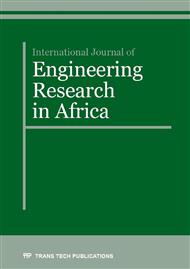[1]
Liu C, Shi K, Wang F. Mass and mass center identification of target satellite after rendezvous and docking. Intelligent Control and Automation (WCICA), 2014 11th World Congress on. IEEE, 2014: 5802-5807.
DOI: 10.1109/wcica.2014.7053711
Google Scholar
[2]
Shi K, Liu C, Sun Z, et al. Mixed H2/H∞ approach of full order state observer design for satellite attitude control system. Control and Decision Conference (CCDC), 2015 27th Chinese. IEEE, 2015: 4513-4517.
DOI: 10.1109/ccdc.2015.7162720
Google Scholar
[3]
Liu S, Zhang R, Zhang J. Robust H∞ Control of a Class Sample-Data System for Satellite Attitude Control with Structured Uncertainty. Aerospace Control, 2012, 30(6): 50-53.
Google Scholar
[4]
GASSARA H, HAJJAJI A E, CHAABANE M. Robust H∞ control for T-S fuzzy systems with time-varying delay. International Journal of Systems Science, 2010, 41(12): 1481-1491.
DOI: 10.1080/00207720903353658
Google Scholar
[5]
XIA Y, QIU J, ZHANG J, et al. Delay-dependent robust H∞ control for uncertain stochastic time-delay system. International Journal of Systems Science, 2008, 39(12): 1139-1152.
DOI: 10.1080/00207720802088256
Google Scholar
[6]
REN J, ZH Q. Robust H∞ control for uncertain descriptor systems by proportional-derivative state feedback. International Journal of Control, 2010, 83(1): 89-96.
DOI: 10.1080/00207170903100222
Google Scholar
[7]
Capua A, Shapiro A, Choukroun D. Robust Nonlinear H∞ Output-Feedback for Spacecraft Attitude Control/ AIAA Guidance, Navigation, and Control Conference, (2014).
DOI: 10.2514/6.2014-0455
Google Scholar
[8]
MAHMOUD M S, ZRIBI M. H∞-controllers for time-delay systems using linear matrix inequalities. Journal of Optimization Theory and Applications, 1999, 100(1): 89-122.
DOI: 10.1023/a:1021716931374
Google Scholar
[9]
ISIDORI A, KANG W. H∞ control via measurement feedback for general nonlinear systems. IEEE Transactions on Automatic Control, 1995, 40(3): 466-472.
DOI: 10.1109/9.376058
Google Scholar
[10]
Palhares R M, Peres P L D. LMI approach to the mixed H2/H∞ filtering design for discretetime uncertain systems. Aerospace and Electronic Systems, IEEE Transactions on, 2001, 37(1): 292-296.
DOI: 10.1109/7.913689
Google Scholar
[11]
Grigoriadis K M, Watson Jr J T. Reduced-order H∞ and L2-L∞ filtering via linear matrix inequalities. Aerospace and Electronic Systems, IEEE Transactions on, 1997, 33(4): 1326-1338.
DOI: 10.1109/7.625133
Google Scholar
[12]
Li H, Fu M. A linear matrix inequality approach to robust H∞ filtering. Signal Processing, IEEE Transactions on, 1997, 45(9): 2338-2350.
DOI: 10.1109/78.622956
Google Scholar
[13]
Wu L, Wang Y, Zhou S, et al. Design of mixed H-two/H-infinity optimal control systems using multiobjective differential evolution algorithm. Journal of Control Theory and Applications, 2013, 11(3): 521-528.
DOI: 10.1007/s11768-013-1156-5
Google Scholar
[14]
Molina-Cristóbal A, Griffin I A, Fleming P J, et al. Linear matrix inequalities and evolutionary optimization in multiobjective control. International Journal of Systems Science, 2006, 37(8): 513522.
DOI: 10.1080/00207720600783942
Google Scholar
[15]
Hwang C, Han S. Mixed H2/H∞ design for a decentralized discrete variable structure control with application to mobile robots. Systems, Man, and Cybernetics, Part B: Cybernetics, IEEE Transactions on, 2005, 35(4): 736-750.
DOI: 10.1109/tsmcb.2005.845999
Google Scholar
[16]
Moghadam M G, Jamshidi F, Beheshti M T H. The Multiobjective H2/H∞ Impulse-to-peak Output-Feedback Control via LMI Optimization. Advanced Computer Control, 2009. ICACC'09. International Conference on. IEEE, 2009: 281-286.
DOI: 10.1109/icacc.2009.129
Google Scholar
[17]
Sun C, Chang W, Chung H. H2/H∞ Robust Static Output Feedback Control Design via Mixed Genetic Algorithm and Linear Matrix Inequalities. Journal of dynamic systems, measurement, and control, 2005, 127(4): 715-722.
DOI: 10.1115/1.2098967
Google Scholar
[18]
Chung H, Chan S. GA-based H2/H∞ static output feedback design with average performance concept and techniques of family of polynomials. Expert Systems with Applications, 2009, 36(3): 5859-5865.
DOI: 10.1016/j.eswa.2008.07.071
Google Scholar


